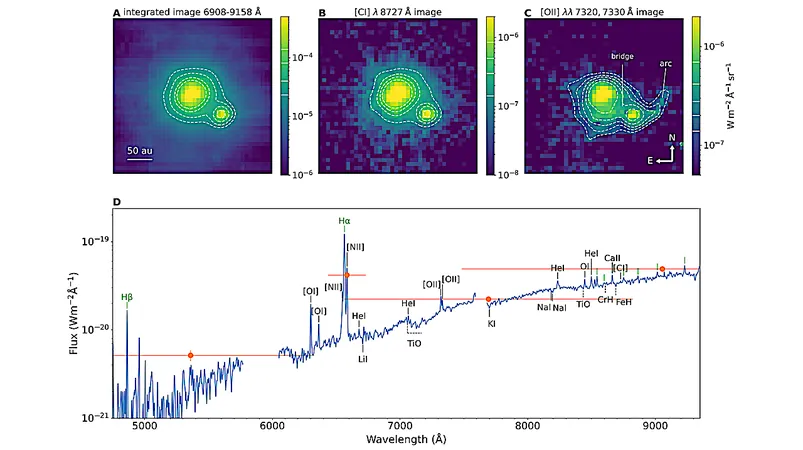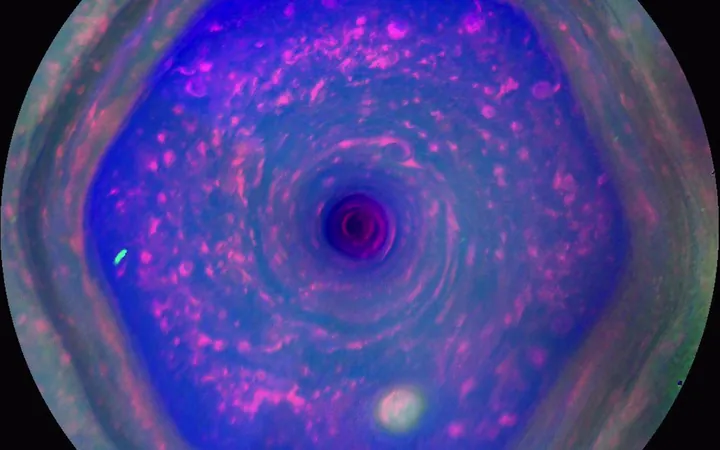
Astronomers Unveil First Direct Image of the Cosmic Web: A Stunning View of the Universe's Hidden Highways!
2025-06-29
Author: Sophie
Space: Not as Empty as You Think!
In the vast expanse of the universe, space isn’t just a void; it’s intricately woven with strands of matter so faint that even our most advanced telescopes struggle to spot them. This mysterious network is known as the cosmic web, serving as the fundamental structure that holds galaxies together and influences their evolution.
Breaking New Ground: A Filament Comes to Light!
For years, the finest filaments of this cosmic web existed only in simulations and educated conjectures. But a groundbreaking discovery has finally brought one of these ethereal strands into full view, marking a significant milestone for astronomers.
The breakthrough observation took place in a section of the sky illuminated by two ancient quasars, burning intensely more than 11 billion light-years away. Their powerful light backlit a delicate bridge of hydrogen connecting them.
A Herculean Effort in Astronomy!
Capturing this elusive filament required an immense commitment, totaling hundreds of hours of telescope time and the ingenuity of forensic astronomy tools. An international team led by the University of Milano-Bicocca, in collaboration with the Max Planck Institute for Astrophysics, honed in on these ancient giants.
Each of the quasars is home to a voracious black hole, existing in a time when the universe was only about 2 billion years old. What they discovered was a slender cosmic strand connecting these galaxies, spanning an astonishing 3 million light-years.
Revolutionary Technology: How They Did It!
The astronomers employed the Multi-Unit Spectroscopic Explorer (MUSE) mounted on the European Southern Observatory’s Very Large Telescope in Chile. This sophisticated instrument captures spectra for every pixel in its sight, allowing researchers to filter the filament’s weak hydrogen emissions from overwhelming background noise.
Understanding the Cosmic Flow!
Since light travels at a finite speed, this image captures the young universe as it was long ago. The filament depicted the movement of gas along a gravitational highway toward the outskirts of the galaxies—an essential source for future star formation. This observation validates a key tenet of cold dark matter theories, positing that galaxies grow by siphoning gas from these interconnected filaments rather than absorbing isolated clouds.
Why This Matters!
Interestingly, cold dark matter models suggest that a staggering 85% of the universe's mass is invisible to traditional telescopes. The newfound filament allows researchers to gain insight into this hidden mass, as its brightness correlates with the surrounding dark matter density.
An Astounding Achievement!
Davide Tornotti, a Ph.D. student at the University of Milano-Bicocca and leader of this study, expressed his excitement: “By capturing the faint light emitted by this filament, which traveled for nearly 12 billion years to reach us, we successfully characterized its shape for the first time.” This research pushes MUSE to its limits, accumulating over 100 hours of data on these cosmic threads.
From Simulation to Reality!
Simulations conducted at the Max Planck Institute portrayed gravity as the architect, gathering dark matter into an everlasting scaffold where ordinary gas can coalesce. Overlaying observed filaments onto simulated ones revealed striking agreements.
Galaxies and the Filament Connection!
The gas flowing along these filaments doesn’t merely transition into stars; it significantly influences galaxy structure. These streams deliver fresh hydrogen to the galaxies, fueling spiral arms and enriching their chemical makeup.
What Lies Ahead for Cosmic Exploration?
While this imaging represents an incredible leap forward, experts caution that it's just the beginning. Fabrizio Arrigoni Battaia, a staff scientist at MPA, noted, “We’re working towards discovering more of such structures to develop a comprehensive understanding of gas distribution in the cosmic web.”
Future research will leverage next-gen instruments like the Extremely Large Telescope's high-resolution spectrographs to unravel the complete map of the universe's scaffolding.
A Bright Future for Astronomical Discoveries!
With every new filament discovered, constraints on dark matter physics and galaxy evolution will tighten, deepening our comprehension of the universe's hidden framework. For now, the beautifully rendered filament connecting two blazing quasars stands as the sharpest image of the cosmic web yet captured, highlighting gas flowing along a spider-silk highway—a sight that proves that dedicated observation can reveal structures once thought unreachable.









 Brasil (PT)
Brasil (PT)
 Canada (EN)
Canada (EN)
 Chile (ES)
Chile (ES)
 Česko (CS)
Česko (CS)
 대한민국 (KO)
대한민국 (KO)
 España (ES)
España (ES)
 France (FR)
France (FR)
 Hong Kong (EN)
Hong Kong (EN)
 Italia (IT)
Italia (IT)
 日本 (JA)
日本 (JA)
 Magyarország (HU)
Magyarország (HU)
 Norge (NO)
Norge (NO)
 Polska (PL)
Polska (PL)
 Schweiz (DE)
Schweiz (DE)
 Singapore (EN)
Singapore (EN)
 Sverige (SV)
Sverige (SV)
 Suomi (FI)
Suomi (FI)
 Türkiye (TR)
Türkiye (TR)
 الإمارات العربية المتحدة (AR)
الإمارات العربية المتحدة (AR)